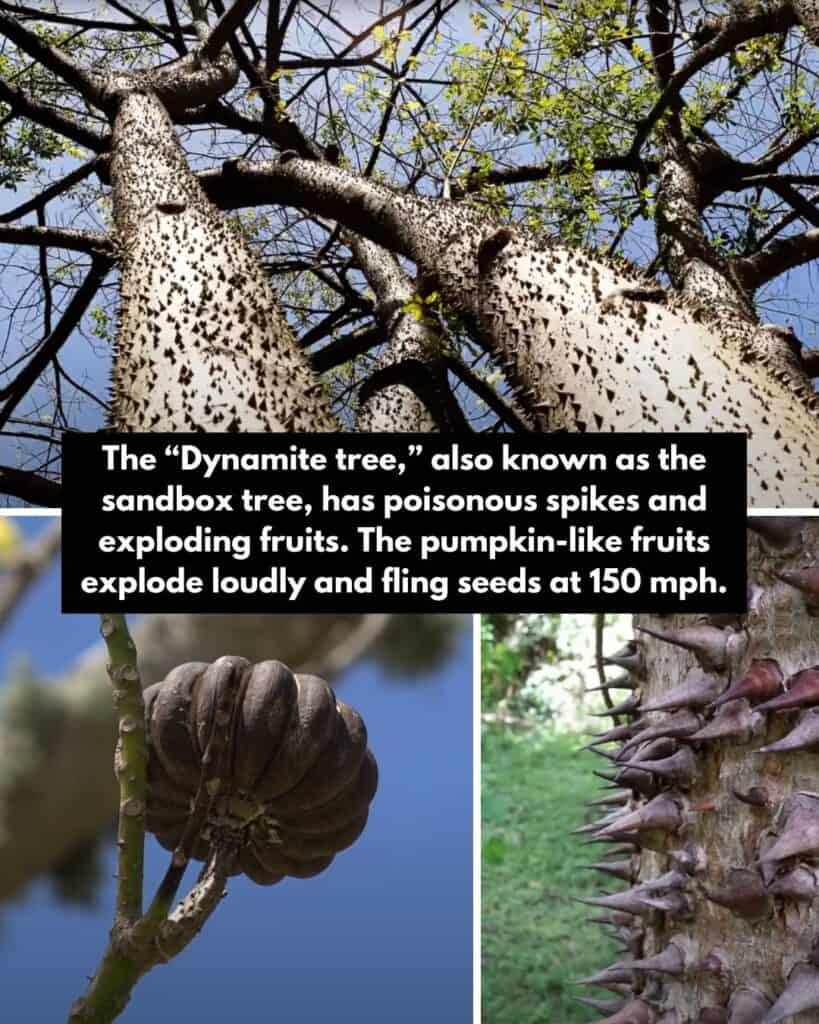The dynamite tree, scientifically known as Hura crepitans, is a notorious species found in tropical regions, particularly in the Americas.
Despite its funny name, this tree is endowed with several lethal characteristics that make it one of the most dangerous trees in the world. Its explosive seed capsules, sharp spikes, and toxic properties have earned it several names, including the sand tree and the monkey-gun tree.
Key points:
- Explosive seed dispersal: The tree’s seed capsules explode when dry, launching seeds at speeds of up to 150 miles per hour, which can cause injury to nearby humans and animals.
- sharp spikes: The trunk is covered in one-inch spikes that prevent climbing and resembles medieval armor.
- Toxic properties: The fruit and sap are highly poisonous, causing severe symptoms such as cramps and vomiting if ingested, and skin rashes or temporary blindness on contact.
- Historical uses: Indigenous people historically used the tree’s toxic sap for hunting by applying it to darts.
- medicinal applications: Despite its dangers, extracts from the tree have been used to treat conditions such as eczema, rheumatoid arthritis, and intestinal worms. Researchers are also studying the oil from its seed as an insecticide.
- Invasive species: The tree has spread to regions such as Tanzania, where it was introduced as a shade tree, posing challenges to local ecosystems due to its rapid growth and competitive nature.
- Cultural reference: The name “sand tree” comes from the historical use of its fruit to contain sand to dry ink before blotting paper became common.
Frequently asked questions
Question: Are there any animals that can safely eat the fruits of the sand tree?
Answer: There are no animals that can safely eat the fruits of the sand tree. The seeds and latex sap of the dusky tree are very poisonous. They contain toxalbumin, a lectin toxin, which can cause serious symptoms such as vomiting, diarrhea and cramps if ingested.
The fruit is not safe to eat, even when ripe, and can cause serious harm to any animal or person that consumes it.
How do exploding seeds affect the ecosystem around the dynamite tree?
The explosive seeds of the dynamite tree significantly impact the surrounding ecosystem in several ways:
- Seed dispersal: The explosive force of the seeds allows them to spread over a wide area, ensuring that new plants grow far from the parent tree. This reduces competition for resources such as sunlight, water and nutrients..
- Danger to wildlife: Ejecting seeds at high speed can harm nearby animals and people. The seeds travel at speeds of up to 240 kilometers per hour, which can cause serious damage if they hit any living being..
- Invasive potential: In regions where the dusky tree is not native, the efficient seed dispersal mechanism can help it spread rapidly, potentially outcompeting local flora and disrupting the local ecosystem..
- Soil enrichment: If the seeds cause injury or death to small animals, the decomposing bodies can provide nutrients to the soil, indirectly benefiting the growth of new plants..
Overall, explosive dispersal of dusky tree seeds is a very effective propagation strategy, but can pose risks to the ecosystem and surrounding wildlife.

